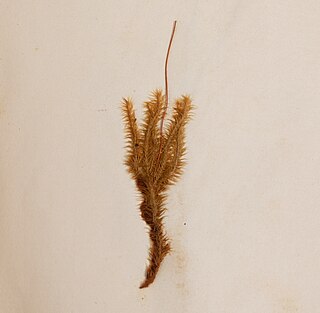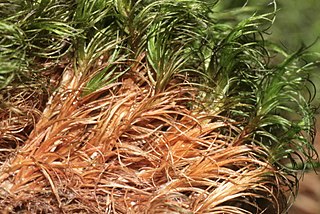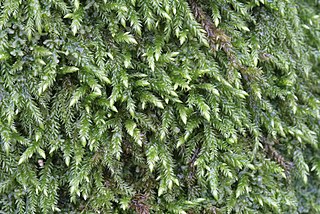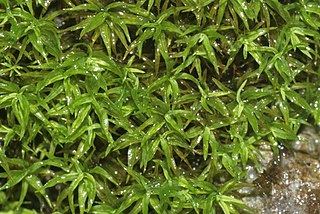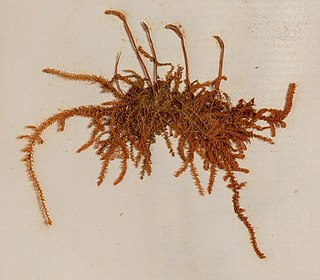| Racomitrium | |
|---|---|
 | |
| Racomitrium lanuginosum | |
| Scientific classification | |
| Kingdom: | Plantae |
| Division: | Bryophyta |
| Class: | Bryopsida |
| Subclass: | Dicranidae |
| Order: | Grimmiales |
| Family: | Grimmiaceae |
| Genus: | Racomitrium Brid. |
Racomitrium is a genus of mosses in the family Grimmiaceae established in 1818 by Samuel Elisée Bridel-Brideri. It contains the following species:
- Racomitrium aciculare Bridel, 1819
- Racomitrium aduncoides Bednarek-Ochyra, 1999
- Racomitrium affine Lindberg, 1875
- Racomitrium afoninae Frisvoll, 1988
- Racomitrium alare Paris, 1900
- Racomitrium albipiliferum C.Gao & T.Cao
- Racomitrium albipiliferum Gao Chien & Cao Tong, 1981
- Racomitrium andreaeoides Herzog
- Racomitrium angustifolium Brotherus, 1929
- Racomitrium aquaticum Bridel, 1819
- Racomitrium aterrimum (Müll.Hal.) Paris
- Racomitrium austrogeorgicum Paris
- Racomitrium barbuloides Cardot, 1908
- Racomitrium bartramii H.Robinson, 1974
- Racomitrium brachypus Paris, 1898
- Racomitrium brevipes Kindberg, 1890
- Racomitrium brevisetum Lindberg, 1872
- Racomitrium canaliculatum Mitt.
- Racomitrium canescens Bridel, 1819
- Racomitrium carinatum Cardot, 1908
- Racomitrium chrysoblastum (Müll.Hal.) Kindb.
- Racomitrium crispipilum Jaeger, 1874
- Racomitrium crispulum J.D.Hooker & Wilson, 1854
- Racomitrium crumianum Fife, 1984
- Racomitrium cucullatifolium Hampe, 1863
- Racomitrium cucullatulum Brotherus, 1929
- Racomitrium curiosissimum Bednarek-Ochyra & Ochyra, 1996
- Racomitrium decurrens Dixon, 1960
- Racomitrium depressum Lesquereux, 1868
- Racomitrium dichelymoides Herzog, 1934
- Racomitrium didymum Lorentz, 1866
- Racomitrium durum (Müll.Hal. ex Broth.) Paris
- Racomitrium ellipticum Bruch & W.P.Schimper, 1845
- Racomitrium elongatum Ehrhart ex Frisvoll, 1983
- Racomitrium emersum Jaeger, 1874
- Racomitrium ericoides Bridel, 1819
- Racomitrium fasciculare Bridel, 1819
- Racomitrium fastigiatum Wallr.
- Racomitrium flavo-pallidum Dusén
- Racomitrium flettii Holz.
- Racomitrium funale (Schwägr.) Huebener
- Racomitrium fuscescens Wilson, 1857
- Racomitrium genuflexum (Müll.Hal.) Ochyra & Matteri
- Racomitrium gracillimum Dixon, 1960
- Racomitrium grimmioides Herzog, 1957
- Racomitrium hausmannianum (De Not.) Molendo
- Racomitrium helvolum (Müll.Hal.) Paris
- Racomitrium hespericum Sérgio, J.Muñoz & Ochyra, 1995
- Racomitrium heterostichoides Cardot
- Racomitrium heterostichum Bridel, 1819
- Racomitrium himalayanum Jaeger, 1874
- Racomitrium hyalinocuspidatum (Müll.Hal.) Kindb.
- Racomitrium japonicum Dozy & Molkenboer, 1847
- Racomitrium joseph-hookeri Frisvoll, 1988
- Racomitrium kerguelense Ochyra & Matteri, 1996
- Racomitrium laetum Bescherelle & Cardot, 1908
- Racomitrium laevigatum Jaeger, 1874
- Racomitrium lamprocarpum Jaeger, 1874
- Racomitrium lanuginosum Bridel, 1819
- Racomitrium lawtonae Ireland, 1970
- Racomitrium lepervanchei Bescherelle, 1880
- Racomitrium lusitanicum Ochyra & Sérgio, 1992
- Racomitrium macounii Kindberg, 1889
- Racomitrium marginatum Lojacono, 1884
- Racomitrium membranaceum Paris, 1898
- Racomitrium microcarpum Bridel, 1819
- Racomitrium microcarpum x heterostichum
- Racomitrium minutum Ochyra & Matteri, 1996
- Racomitrium muticum Frisvoll, 1983
- Racomitrium nigritum Jaeger, 1874
- Racomitrium nigroviride (Müll.Hal.) Paris
- Racomitrium nipponicum Sakurai
- Racomitrium nitidulum Cardot, 1908
- Racomitrium nivale (Köckinger, Bedn.-Ochyra & Ochyra) Köckinger
- Racomitrium norrisii Bednarek-Ochyra & Ochyra, 2000
- Racomitrium obesum Frisvoll, 1988
- Racomitrium obtusifolium (P.Beauv.) Brid.
- Racomitrium obtusum Bridel, 1819
- Racomitrium occidentale Renauld & Cardot, 1892
- Racomitrium ochraceum Ochyra & Matteri, 1996
- Racomitrium orientale (Cardot) Sakurai
- Racomitrium orthotrichaceum Paris, 1898
- Racomitrium pachydictyon Cardot, 1908
- Racomitrium pacificum Ireland & Spence, 1987
- Racomitrium panschii Kindberg, 1897
- Racomitrium papeetense Bescherelle, 1894
- Racomitrium patagonicum Bednarek-Ochyra & Ochyra, 2003
- Racomitrium phyllanthum (Lindb. ex Broth.) Warnst.
- Racomitrium pruinosum (Wilson) Müll.Hal.
- Racomitrium pruinosum C.Müller, 1869
- Racomitrium pseudoaciculare (Müll.Hal.) Paris
- Racomitrium pseudopatens Paris, 1900
- Racomitrium ptychophyllum Mitten, 1867
- Racomitrium pygmaeum Frisvoll, 1983
- Racomitrium rigidissimum (Müll.Hal.) Paris
- Racomitrium rupestre Wilson & J.D.Hooker, 1854
- Racomitrium ryszardii Bednarek-Ochyra, 2000
- Racomitrium seychellarum Bescherelle, 1880
- Racomitrium steerei Griffin, 1987
- Racomitrium strictifolium (Mitt.) A.Jaeger
- Racomitrium subcrispipilum (Müll.Hal.) A.Jaeger
- Racomitrium sublamprocarpum (Müll.Hal.) Paris
- Racomitrium subnigritum (Müll.Hal.) Paris
- Racomitrium subrupestre Roivainen, 1955
- Racomitrium subsecundum Mitten, 1857
- Racomitrium subulifolium Cardot
- Racomitrium sudeticum Bruch & W.P.Schimper, 1845
- Racomitrium sulcipilum Paris, 1898
- Racomitrium sullivanii (Müll.Hal.) Broth.
- Racomitrium symphyodontum (Müll.Hal.) Paris
- Racomitrium valdon-smithii Ochyra & Bednarek-Ochyra, 1999
- Racomitrium varium Jaeger, 1874
- Racomitrium venustum Frisvoll, 1988
- Racomitrium verrucosum Frisvoll, 1988
- Racomitrium visnadiae W.R.Buck, 1997
- Racomitrium vulcanicola Frisvoll & Deguchi, 1988
- Racomitrium vulcanicum Lorentz, 1864
- Racomitrium willii (Müll.Hal.) Kindb.
- Racomitrium zygodonticaule (Müll.Hal.) Paris


